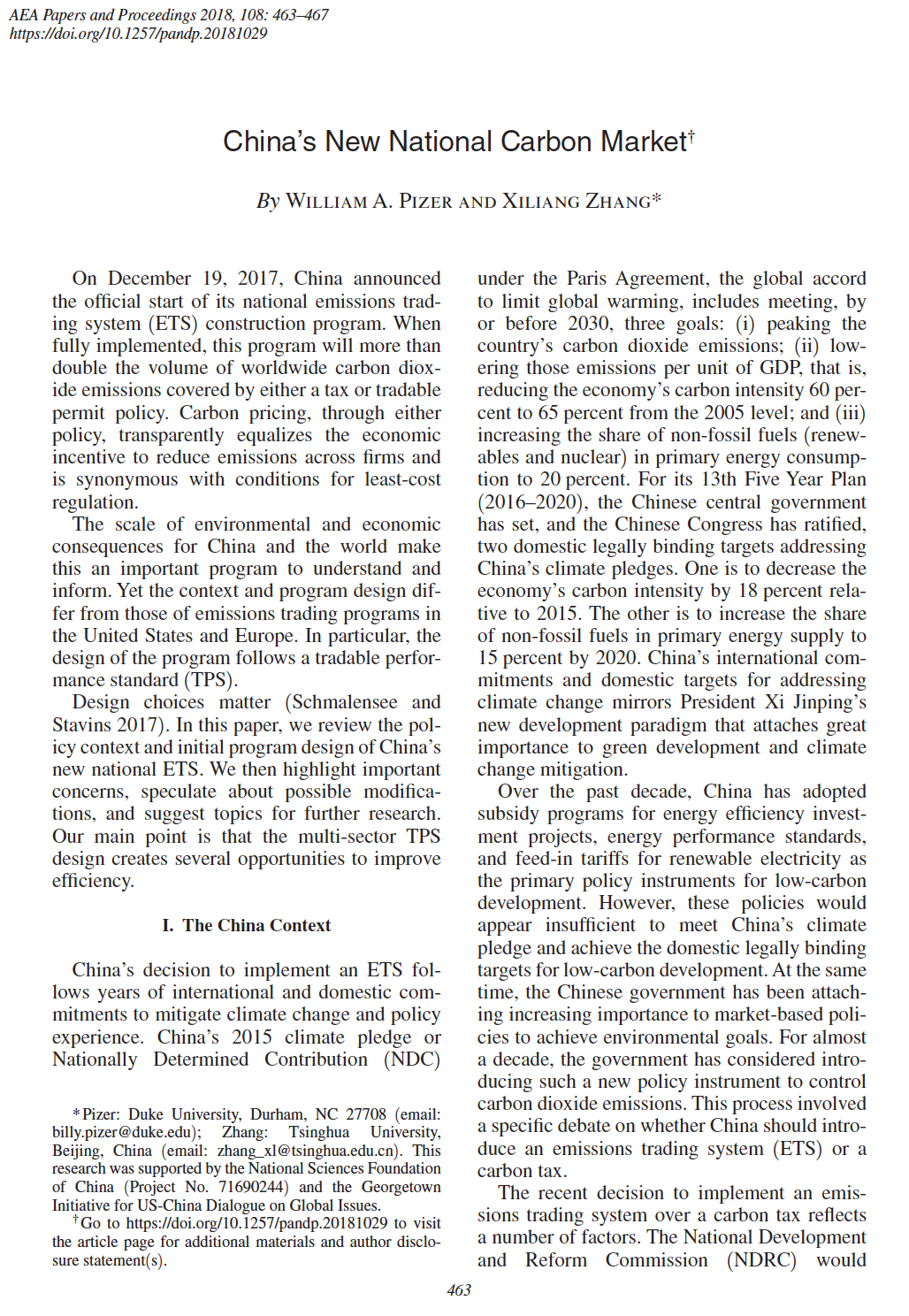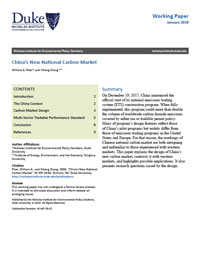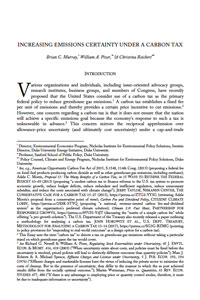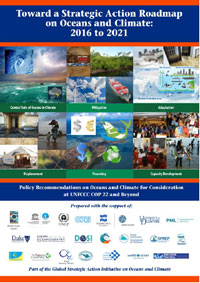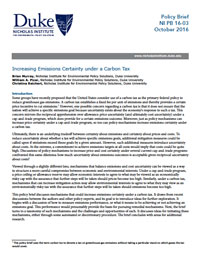Publications
China’s New National Carbon Market
This article in the journal AEA Papers and Proceedings reviews the policy context and initial program design of China’s new national emissions trading system. It explains the design of China’s new carbon market, contrasts it with western markets, and highlights possible implications. The article reflects some of the findings in the working paper “China’s New National Carbon Market,” published by the Nicholas Institute for Environmental Policy Solutions.
Regional Implications of National Carbon Taxes
This analysis published in the journal Climate Change Economics examines impacts of nationally-imposed carbon taxes on different regions of the United States. The goal is to see what can be learned about the drivers of regional political support for and opposition to such measures. Whether at the state, regional or national levels, carbon taxes are one option for reducing greenhouse gas emissions; several state and regional programs are already under way and lowering emissions. This analysis uses a U.S. regional version of the Dynamic Integrated Economy/Energy/Emissions Model (DIEM) computable general equilibrium model to explore relationships between carbon taxes, emissions, and economic growth.
The Future of the Electricity Industry: Implications of Trends and Taxes
This analysis published in the journal Energy Economics examines how changes in market trends and technology costs are likely to affect electricity generation in the United States in the context of possible future carbon taxes. It uses the Dynamic Integrated Economy/Energy/Emissions Model (DIEM) electricity-sector model to examine a wide range of sensitivity cases for technology and fuel costs under different economic conditions. The model finds that carbon taxes can be an effective way to quickly lower emissions. Shifts among natural gas and renewable generation can vary significantly, depending on capital and operating costs.
China's New National Carbon Market
On December 19, 2017, China announced the official start of its national emissions trading system (ETS) construction program. When fully implemented, this program could more than double the volume of worldwide carbon dioxide emissions covered by either tax or tradable permit policy. Many of program’s design features reflect those of China’s pilot programs but widely differ from those of emissions trading programs in the United States and Europe. For that reason, the workings of Chinese national carbon market are both intriguing and unfamiliar to those experienced with western markets. This paper explains the design of China’s new carbon market, contrasts it with western markets, and highlights possible implications. It also presents research questions raised by the design.
What’s the Damage from Climate Change?
This contribution to Science's Perspectives underscores the importance of work to update estimates of the cost of carbon dioxide emissions, a cost that pervades government policy making. It explains the efforts of an interagency group charged with improving estimates of the so-called social cost of carbon (SC-CO2)—the dollar value of damage associated with 1 ton of additional emissions—and hence its equivalent, the benefit of avoided damage. It explains that in 2017 a U.S. National Academy of Science panel recommended use of updated damage models that translate climate change into impacts measured against the baseline economic activity and population. An improved damage model architecture for the United States has produced new estimates: 3 degrees Celsius of warming would lead to a loss of ~2 percent of U.S. gross domestic product; 6 degrees Celsius of warming would lead to a ~6 percent loss. But the real value of the new model architecture is enhanced credibility for future benefit estimates built on it and the architecture’s capacity to incorporate new studies and additional economic sectors.
Increasing Emissions Certainty under a Carbon Tax
Should the United States consider use of a carbon tax as the primary federal policy to reduce greenhouse gas emissions? A carbon tax establishes a fixed fee per unit of emissions and thereby provides a certain price incentive to cut emissions—but it does not ensure that the nation will achieve a specific emissions goal because the economy’s response to the tax is unknown in advance. Ultimately, there is an underlying tradeoff between certainty about emissions and certainty about prices and costs. Mechanisms that balance emissions and cost uncertainty can be viewed as a way to structure a more careful compromise between cost concerns and environmental interests. Under a carbon tax, mechanisms that can increase mitigation action may allow environmental constituencies to agree to what they may view as an environmentally risky tax with the assurance that further steps will be taken should emissions become too high. This symposium essay in the Harvard Environmental Law Review discusses mechanisms that could increase emissions certainty under a carbon tax.
Resolving the Inherent Uncertainty of Carbon Taxes
This introduction to symposium essays in the Harvard Environmental Law Review describes the role of pricing carbon in contemporary climate change policy (with a summary of experience with carbon tax and cap-and-trade policies around the world) and points out similarities of carbon tax policies and cap-and-trade policies based on the academic literature. But it focuses on how a tax and cap-and-trade schemes differ in terms of their economic and emission outcomes in light of the uncertainty characterizing the markets and economies in which these instruments are used. These differences have potentially important economic, environmental, and political economy implications for U.S. climate change policy. Finally, the article highlights the proposals and key findings of each of the symposium essays, including Increasing Emissions Certainty under a Carbon Tax.
Valuing Climate Damages: Updating Estimation of the Social Cost of Carbon Dioxide
To estimate the social cost of carbon dioxide for use in regulatory impact analyses, the federal government should use a new framework that would strengthen the scientific basis, provide greater transparency, and improve characterization of the uncertainties of the estimates, says a new report by the National Academies of Sciences, Engineering, and Medicine. The report also identifies a number of near- and longer-term improvements that should be made for calculating the social cost of carbon.
Toward a Strategic Action Roadmap on Oceans and Climate: 2016 to 2021
This comprehensive set of policy recommendations on oceans and climate for consideration at the United Nations Framework Convention on Climate Change 22nd Conference of the Parties and beyond is aimed at recognizing the central role of oceans in climate and the need to implement stringent reductions in greenhouse gas emissions to avoid disastrous consequences for coastal and island communities, marine ecosystems, and ocean chemistry. The recommendations from the International Expert Working Group on Oceans and Climate address mitigation, adaptation, displacement, financing, and capacity development.
Increasing Emissions Certainty under a Carbon Tax
To reduce greenhouse gas emissions, some groups have proposed that the United States consider use of a carbon tax. But whether the nation will achieve a specific emissions goal is uncertain because the economy’s response to such a tax is uncertain. Ultimately, there is an underlying tradeoff between certainty about emissions and certainty about prices and costs. To reduce uncertainty about whether a tax will achieve specific emissions goals, additional mitigation measures could be called on if emissions exceed those goals by a given amount. However, such additional measures introduce uncertainty about costs. At the extreme, a commitment to achieve emissions targets at all costs would imply that costs could be quite high. Discussions of policy mechanisms to increase price and cost certainty under several current cap-and-trade programs confronted this same dilemma: how much uncertainty about emissions outcomes is acceptable given reciprocal uncertainty about costs? Viewed through a slightly different lens, mechanisms that balance emissions and cost uncertainty can be viewed as a way to structure a more careful compromise between economic and environmental interests. This policy brief discusses mechanisms that could increase emissions certainty under a carbon tax.

